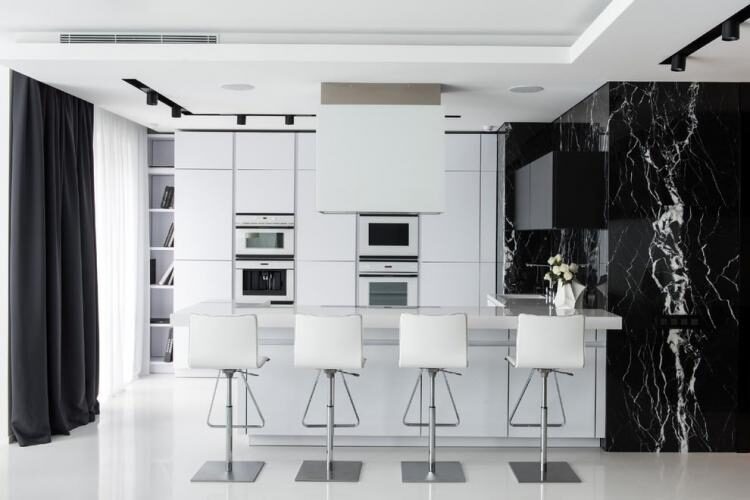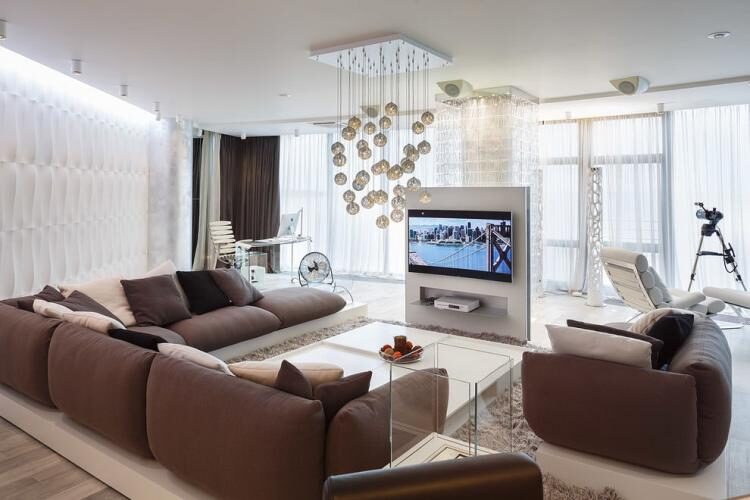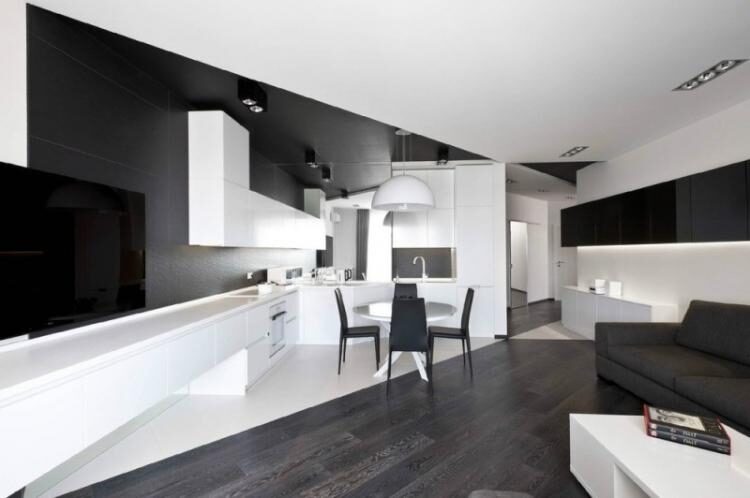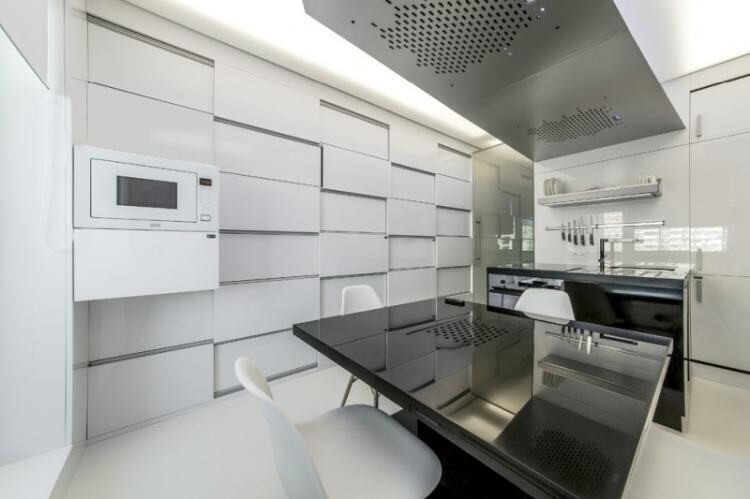The bold and truly unique high-tech style in interior design surprises and amazes with its originality. It is strict, dynamic, and at the same time comfortable. The use of technology in the decor successfully conveys the spirit of modernity, making it ideal for decisive, creative individuals who reject the ordinary. In this article, we will take a detailed look at the main features of the trend and the proper design of various rooms in the spirit of hi-tech!
The Features of the High-Tech Style
The style emerged in the second half of the 20th century and was initially reflected in architecture before quickly gaining popularity in everyday life. High-tech design significantly differs from others and, at the same time, combines perfectly with many of them (loft, fusion, modern, etc.).
Designing an apartment or house in the high-tech style is not an easy task, as it requires considerable financial investment, due to the presence of new technology, furniture, lamps, and other components. In addition, it is important to understand the basic features that distinguish the interior, namely:

- Conciseness and functional minimalism. Every item serves a purpose. There is no place for excessive decorations and accessories, lush textiles, and picture galleries. The idea is based on clear and simple geometry with strict lines.
- Industrial components are used, such as metal, plastic, glass, and concrete. Wooden items are often covered with shiny plastic.
- The interior has many lighting fixtures. Hidden sources of internal lighting are welcome.
- The predominant color palette includes black, white, gray, metallic, and rich blue.
- Sliding partitions serve as doors, while blinds or roller blinds replace window textiles.
- Ultra-modern household appliances take center stage.
- High-tech style does not hide communication lines. Therefore, various pipes, hoods, and convectors can remain visible.
The main motif of the high-tech style in interiors is the steel shine, geometric construction, and technical themes. The decoration of a spacious and bright room is primarily made up of electronics, endowed with the latest developments that use remote or touch control. This style is close to the spirit of young people who follow new trends.

Materials and Decor
One of the leading roles in this design is creating a common background. This concerns the choice of suitable finishing materials and their color palette. Preference is given to the use of artificial materials, and natural ones, such as wood, are rarely used.
Floor Finishing
The flooring surface is decorated with a monochrome glossy ceramic tile, laminate, parquet, and in a budget option, you can choose neutral-colored linoleum. The best option for high-tech is a poured floor.

Wall Finishing
The materials used include vinyl wallpaper without any patterns or more suitable metallized canvases. Another good option is to use plastic panels or painting.
You can choose white, gray, or sandy shades. In some design concepts, concrete panels are left without additional finishing. Fashionable methods such as casting with architectural concrete and partial facing with stone are also popular.

Designing the Ceiling
As one of the principles of the high-tech style is shine and gloss, a glossy stretch ceiling will look best. A multi-level ceiling can be created using gypsum plasterboard sheets, adding a hidden LED strip.
A simpler but equally suitable solution is a smooth painted surface. The tone does not necessarily have to be chosen from a light palette. In large spaces, black or dark blue gloss with spotlights looks magnificent.


Furniture in the Hi-tech Style
The high-tech interior design leans towards minimalism while prioritizing high functionality. This includes cabinets and dressers that offer maximum storage space. Cabinets that mimic wall panels are an excellent option. Features such as glossy plastic facades, glass open shelving, and shiny metal hardware are highly prized in this style.
Transformable furniture also fits this style perfectly. Consider compact furniture that can serve multiple purposes, like a coffee table that can expand into a dining table for 10 people, or a bed that can transform into a cabinet. These designs highlight the modern aspect of the style and contribute to a feeling of spatial freedom.

Lighting and Decor
Since hi-tech design calls for full lighting, the lighting will be multi-levelled. The superiority of technology is reflected in the lighting fixtures themselves. They have geometric shapes, a metallic shine, and are often equipped with features such as motion sensors, touch panels, remote controls, and devices for adjusting lighting modes.
The unique feature of hi-tech design is the almost complete absence of decor. Original forms created by modern designers make lighting fixtures true decorations themselves.

Spot ceiling lighting is a typical choice for high-tech design. You could also use chandeliers, but they should be geometrically shaped, like a sphere, trapezoid, or cube. Concealed lighting options are also popular, such as illuminated strips and fixtures tucked into ceiling niches. Neon lighting often lights up floor surfaces and furniture pieces, creating a sense of levitation and expansiveness.
Lampshades for wall and floor lamps should consist of plastic, glass, or metal, entirely excluding textiles. Suspended string lights serve wonderfully for zoning the space.
Minimal room decoration is key. Apart from technology, decorations could include vases, metal, plastic or glass figurines, black and white photographs or graphic images in modest frames, wall clocks with an intricate design and visible inner workings, or unusually shaped mirrors arranged into a panel.

Hi-tech Design in Interior Design
Hi-tech Design in Interior Design
When choosing a particular style of home decor (in this case, hi-tech), it’s important to ensure that every room matches the overall technological concept, while allowing each room to have its own unique feature.
Living Room Design in Hi-tech Style
The living room, the hub for family gatherings and guest entertainment, should align with the overall technological theme. It’s best to decorate the living room using a monochromatic color scheme, selecting one primary color palette with various shades. For instance, one wall, where the home theater will be situated, can be accentuated for added emphasis. Essential elements include a large TV, climate control system, a sizeable electric fireplace, and other modern technologies.
Minimalist furniture is key – consider modular designs with lacquered facades and attractive chromed metal details, choosing components as necessary.
Glass items are also welcome: transparent wall shelves, cabinets, and a coffee table will add lightness. Soft sofas and armchairs have leather upholstery without frills. A bright-colored (red, blue) modular sofa can become the main accent. Its ability to take on different forms will help to conveniently seat guests.







Hi-tech Design in Bedroom
It’s hard to imagine a bedroom designed with full strictness, so cozy elements are often added to its design. A bed with neon lighting complements a long pile carpet, while beige textiles add a special coziness against the background of gray walls. For the floor, its better to use pastel-colored laminate or wide planks.
Its best to limit yourself to a minimal set of furniture here. A bed, bedside tables, and a dresser are enough. An interesting solution for a small hi-tech style bedroom is a bed that incorporates various equipment – from a TV to various gadgets.






Hi-tech Design in Children’s Room
It’s best to design a child’s room in this style during their teenage years since younger children will be more interested in superhero images against colorful walls.
Hi-tech design is more acceptable for boys rooms. It’s better to use light wall finishes, such as light gray as the base color. Bright furniture elements will liven up the color palette, such as broken shelves above the desk, glossy facades combined with metal hardware, and a chair in a saturated blue, white or even yellow color.
The children’s room is the perfect place for suspended figurative ceilings with glossy stretched film and lighting, which can also be applied to furniture. Modern technology should also be present in this room, such as a small plasma TV, a computer (including a backlit keyboard and mouse), a laptop, remote-controlled window blinds, and adjustable lighting.






Hi-tech Design in Kitchen
For a hi-tech kitchen finish, a light color palette is preferable, while for the cabinetry, cool undertones like black, silver, or beige are fitting. The backsplash above the work area deserves special attention. Decorative options include tempered glass, single-color ceramic tiles, or stainless steel panels.
Kitchen cabinets need to be spacious, capable of housing appliances such as a refrigerator, washing machine, dishwasher, microwave, oven, and stovetop. Modern hardware, featuring built-in mechanisms for opening and closing as well as soft-close hinges, is a must. Cabinet doors tend to open upwards, not sideways. Glossy facades are better as they provide the necessary shine and make small spaces appear larger.
Lighting should be bright above the work area, with a spherical metal chandelier potentially hung above the dining area. Decorative elements may include hanging vases in stark pots, wall clocks, and, of course, appliances.








Designing a High-Tech Bathroom
Rooms in the high-tech style often feature combined bathrooms, offering enough free space while accommodating all the necessary plumbing fixtures. A modern shower cabin with sliding glass doors and the latest features often takes the place of the traditional bathtub.
In high-tech style rooms, the installation of wall-mounted toilets, bidets, and cabinets with sinks made of glass, stone, or metal is typical. The emphasis is on technological features such as faucets with LED lighting, touch panels, soft-close hinges on toilet and bidet covers, and integrated shower systems with control panels.
Ceramic tiles are the go-to material for wall and floor finishes, while the ceiling can be adorned with a stretch fabric. The chosen color palette generally leans towards lighter shades like grays or browns. Nonetheless, brighter and even darker shades, including black, are acceptable in larger spaces.













Leave feedback about this